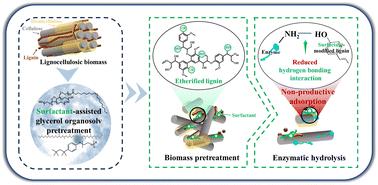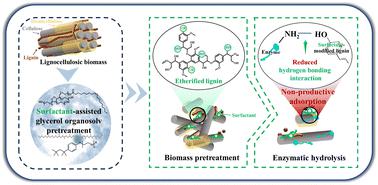揭开在有机溶胶预处理木质纤维素生物质过程中利用表面活性剂改良策略高效生产可发酵糖的秘密
IF 11.3
1区 化学
Q1 CHEMISTRY, PHYSICAL
引用次数: 0
摘要
对木质纤维素生物质进行碱性催化的有机溶胶预处理可获得极佳的木质素脱除效果,从而产生富含全纤维素的底物,用于生产可发酵糖。然而,完全去除木质素并不现实,残留的木质素还会加剧对后续酶水解的负面影响。为解决这一问题,本文提出了一种新的策略,即开发表面活性剂辅助有机溶剂预处理(Triton-X 100、AEO 9 和 Tween 80),对木质素进行原位改性。结果表明,经预处理的基质显示出相当高的酶水解性,与未添加表面活性剂的对照组相比,糖产量提高了 15.7%-38.3%。表面活性剂可通过醚化作用接枝到残留和溶解的木质素上,形成α-醚化木质素,但不会显著改变木质素的组分分布和基质相关特性。量子化学计算从理论上证明了木质素与表面活性剂之间的强 H 键和明显的相互作用能(最大值为 -48.4 kcal mol-1)。特别是,这种表面活性剂改性使残留木质素中脂肪族 -OH 和酚类 -OH 的含量分别降低了 16.0%-22.4% 和 13.8%-28.8% 。-OH基团的减少通过H键相互作用减轻了木质素和纤维素酶之间的非生产性吸附,这与酶水解性的增加有显著的相关性(>-0.9)。总之,这项研究为从根本上理解表面活性剂辅助预处理过程中木质素改性以及酶水解过程中木质素与酶相互作用的机理提供了宝贵的见解。新发现强调了表面活性剂在有机溶胶预处理中的潜在应用,为开发高效的酶介导木质纤维素糖平台提供了可行的方法。本文章由计算机程序翻译,如有差异,请以英文原文为准。


Unraveling the secrets of harnessing a surfactant-modified strategy in organosolv pretreatment of lignocellulosic biomass for efficient fermentable sugar production†
Alkaline-catalyzed organosolv pretreatment of lignocellulosic biomass affords excellent delignification, yielding a holocellulose-rich substrate for fermentable sugar production. However, complete lignin removal is impractical, and residual lignin also exacerbates negative effects on subsequent enzymatic hydrolysis. Herein, a novel strategy of developing surfactant-assisted organosolv pretreatment (Triton-X 100, AEO 9 and Tween 80) for in situ lignin modification was proposed to overcome this issue. The results indicated that the pretreated substrates showed considerable enzymatic hydrolyzability with a 15.7%–38.3% higher sugar yield compared to the control group without surfactants. Surfactants could graft on both residual and dissolved lignin through etherification, forming α-etherified lignin, though without significantly changing the component distribution and substrate-related properties. Quantum chemical calculations provided theoretical evidence of strong H-bonding and pronounced interaction energy between lignin and surfactants (maximally at −48.4 kcal mol−1). In particular, this surfactant modification decreased the aliphatic –OH and phenolic –OH contents of residual lignin by 16.0%–22.4% and 13.8%–28.8%, respectively. The reduction of –OH groups mitigated non-productive adsorption between lignin and cellulases via H-bonding interaction, which exhibited a significant correlation with the increased enzymatic hydrolyzability (>−0.9). Overall, this study offers valuable insight into the fundamental understanding of the mechanism involved in lignin modification during surfactant-assisted pretreatment and lignin–enzyme interaction during enzymatic hydrolysis. The new findings underscore the potential application of surfactants in organosolv pretreatment to achieve a feasible approach for developing an efficient enzyme-mediated lignocellulosic sugar platform.
求助全文
通过发布文献求助,成功后即可免费获取论文全文。
去求助
来源期刊

ACS Catalysis
CHEMISTRY, PHYSICAL-
CiteScore
20.80
自引率
6.20%
发文量
1253
审稿时长
1.5 months
期刊介绍:
ACS Catalysis is an esteemed journal that publishes original research in the fields of heterogeneous catalysis, molecular catalysis, and biocatalysis. It offers broad coverage across diverse areas such as life sciences, organometallics and synthesis, photochemistry and electrochemistry, drug discovery and synthesis, materials science, environmental protection, polymer discovery and synthesis, and energy and fuels.
The scope of the journal is to showcase innovative work in various aspects of catalysis. This includes new reactions and novel synthetic approaches utilizing known catalysts, the discovery or modification of new catalysts, elucidation of catalytic mechanisms through cutting-edge investigations, practical enhancements of existing processes, as well as conceptual advances in the field. Contributions to ACS Catalysis can encompass both experimental and theoretical research focused on catalytic molecules, macromolecules, and materials that exhibit catalytic turnover.
 求助内容:
求助内容: 应助结果提醒方式:
应助结果提醒方式:


